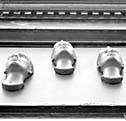
Comment
on this story
Seven Days
Wednesday, June 14
* The University of Tennessee announces plans to bring the school's tutoring program for athletes under the authority of an academic arm of the university. However, the university's entire academic program was then transferred under the umbrella of the new College of Football Studies, whose first dean will be Doug Dickey. Administration offices will be moved into the Neyland Stadium sky boxes.
* Attorney General Paul G. Summers declares to state legislators that their failure to pass a budget by the July 31 deadline could be "a fiscal and legal train wreck of historic proportions." Lawmakers continue to argue.
Thursday, June 15
* A study released by the Surface Transportation Policy Project names Knoxville as one of the safest cities in Tennessee for pedestrians—safer, in fact, than both Memphis and Nashville. Thank pedestrian-unfriendly road design for the low numbers; if nobody walks, it's easy to keep fatal pedestrian-meets-car encounters to a minimum.
Saturday, June 17
* U.S. Interior Secretary Bruce Babbit designates 61,000 acres of Fall Creek Falls State Park's 86,000-acre watershed off-limits to strip coal mining. After years of complaints from green advocates, the U.S. Office of Surface Mining ruled earlier this year that strip mining is indeed a threat to the park's streams. So it's been limited to just 25,000 acres.
Tuesday, June 20
* In a report on the state's budget crisis, National Public Radio remarks that Tennessee is one of the few states in these economic boom times to be struggling financially. We do things a little differently in these parts.
Knoxville Found

What is this? Every week in "Knoxville Found," we'll print the photo of a local curiosity. If you're the first person to correctly identify this oddity, you'll win a special prize plucked from the desk of the editor (keep in mind that the editor hasn't cleaned his desk in five years). E-mail your guesses, or send 'em to "Knoxville Found" c/o Metro Pulse, 505 Market St., Suite 300, Knoxville, TN 37902.
Last Week's Photo:
Joan Collins of Knoxville correctly identified the Egyptian-style sphinx as being one of a pair located in the parking lot of the Kerbela Temple off Mimosa Avenue in South Knoxville. Wayne Bell, official recorder of the Kerbela Temple, says the fiberglass statues are new additions with no particular relevance other than to "give a little mystique" to the Temple's entrance. As our Grand Prize Winner, Ms. Collins will be awarded an unread copy of Sense Ability(tm): Expanding Your Sense of Awareness for a Twenty-First Century Life by Doris Wild Helmering. Congratulations, Joan!
Meet Your City
A calendar of upcoming public meetings you should attend
Knox County Commission
Monday, June 26 * 2 p.m. * Main Assembly Room of City County Building
County Commission will consider a proposed tax rollback now that plans for a downtown Justic Center have stalled. The tax rollback was forwarded to County Commission without recommendation by the county's Intergovernmental Committee on June 19.
Public Building Authority
Wednesday, June 28 * 5:30 p.m. * Tennessee Theatre
The long-awaited plan for downtown development will finally be unveiled as consultants Ron Watkins and Earl Worsham make their formal presentation to PBA. Will their plans call for a climate-controlled dome over Market Square? How much will E.W. Scripps be involved? Is a Saks Fifth Avenue department store in the works? Just who is going to build that luxury hotel for the convention center? Will there be a place for the mom-and-pop shops? Just who is going to pay for all of this? Will Worsham and Watkins finally show us renderings of their vision? Can't stand the suspense?
Residents may finally get the answers they've been searching for as this secretive plan is made public. For better or worse, this proposal could forever change downtown. Anyone who cares about its future should try to make it.
|
 |

Movie Palace Polish
Plans for renovating the Tennessee Theatre are finally being initiated
After four years of discussion and planning, the Historic Tennessee Theatre Foundation is finally set to raise money for the theater's renovation. The foundation has set an ambitious goal—they hope to raise $15 to $20 million over the next five years to fund a series of restoration and improvement projects, and aim at making the theater a central piece of downtown redevelopment.
Dr. Bill Snyder, former chancellor of the University of Tennessee, a member of the Tennessee Theatre Foundation board, and maestro of the theater's popular Wurlitzer organ, says the fund-raising campaign will start in earnest this fall.
"The first thing to do in fund raising is to conduct a feasibility study to get a handle on how much money can be raised," Snyder says. "That's going on right now. [William Hinman, a consultant hired by the foundation] should be finished by the early fall, and then he'll recommend what he thinks can be done."
The 1,535-seat theater has never had a major renovation. It's been updated—new seats and carpet were added in the 1950s, and broadcasting mogul Jim Dick bought the building in the early '80s, saving it from being demolished and paving the way for the theater's current vitality—but the building is essentially the same as when it was built in 1928. It's not in immediate peril, but its future as Knoxville's grand entertainment palace may depend on the planned improvements.
"The Tennessee Theatre is in remarkably good shape, structurally," says Ashley Capps, president of AC Entertainment, which has managed the theater since 1996. "It needs critical improvements, but it isn't getting ready to fall down. But ultimately it will, if people don't do anything to restore it."
The several individual projects planned—expansion of the back of the stage, improvement of the lobby, dressing rooms, and auditorium, and a $150,000 overhaul of the Wurlitzer—will take place as money comes in, allowing the theater to remain open during the renovations, Snyder says. That schedule—which theater manager Tom Bugg says still hasn't been settled—will also allow the foundation to begin the renovations soon, before the full amount of money is raised. Work on the Wurlitzer, in fact, is scheduled to begin this fall, after the theater's summer film series. The foundation has already received an anonymous donation for the work, and the organ will be shipped to Reno, Nev., for renovations in September and returned 10 months later. While the organ is gone, Snyder says, a rental organ will take its place.
Both Capps and Snyder say that expansion of the stage, which will hang out over State Street at the rear of the building, is a key to the renovation process. The elevated expansion, suspended about 30 feet over the street, will allow the Knoxville Symphony Orchestra and Knoxville Opera Company room to stage productions that they can't perform on the current stage, and will open the theater to "other types of productions that, these days, don't play in Knoxville," Capps says.
Original plans called for extension of the stage all the way across State Street, to be supported by columns on the sidewalk in front of the cemetery at First Presbyterian Church. The church opposed that plan, Snyder says, so the foundation scaled back the design.
"We're not talking just about a restoration," Capps says. "It's going to be a transformation. We're going to take the theater back to its previous glory, but we're also going to prepare it for the next century. We want it to be a fine arts center for the entire region."
More importantly, Capps says, a restored Tennessee Theatre could be a significant part of long-term plans for downtown redevelopment. He cites historic theaters in other cities—the Orpheum in Memphis, the Ryman Auditorium in Nashville, even the Paramount in Bristol—as important elements in reinvigorated downtown areas. "This whole project is extremely important in the context of downtown development," he says. "It's often the case that a fine arts center or historical theater is a cornerstone in successful downtown development."
—Matthew T. Everett
Detoured
While never-ending TDOT construction keeps the Third Creek Bike Trail closed, the city suggests an alternative route
Both last year and this year, the massive Tennessee Department of Transportation construction on the Alcoa Highway connector has posed a big problem for pedestrians and bicyclists who use Tyson Park as a thoroughfare to get between the downtown/UT area and residential points west. The problem is that during certain hours of the day, while bridge construction is underway, Tyson Park is closed—as is part of the Kingston Pike sidewalk, the most obvious alternative pedestrian route.
With no end to the construction in sight, Donna Young, the city's greenway coordinator, has been frustrated that the highway construction has kept the city's recently completed Third Creek Bike Trail closed or compromised. In recent months she has been conferring with TDOT and UT officials, considering every possible solution to the problem. As of this week, she thinks she has found a solution, and it's a surprising one.
It will take cooperation from TDOT, which might do much of the grading for the trail—and from UT, which owns most of the land under consideration for a detour—but here goes:
If all goes well, the greenway will cross Third Creek and depart from Tyson Park uphill to the south, intersecting Kingston Pike near the northbound highway exit, near the Ossoli Circle. Then it will cross Kingston Pike at a yet-to-be-established pedestrian crosswalk and, on the south side of the Pike, track a wide arc around the fringes of Morgan Hill, UT's experimental farm—to rejoin the established bike trail on Neyland Drive, near the Alcoa Highway exit.
Young says TDOT officials have been cooperative and receptive to the idea. Funding would come either from federal T-21 money which Gov. Don Sundquist, for reasons of his own, has diverted away from Knoxville greenway construction in recent years, or from a pot of TDOT money which Young only recently learned is earmarked for construction-related pedestrian detours.
It's not a perfect solution—the detour would add several minutes to some bicycle commuters' east-west trips—but, at least, it will be theoretically possible to ride or walk safely around a TDOT project. And, if and when construction is completed, it should make for a nice jogging circuit.
—Jack Neely

June 22, 2000 * Vol. 10, No. 25
© 2000 Metro Pulse
|





